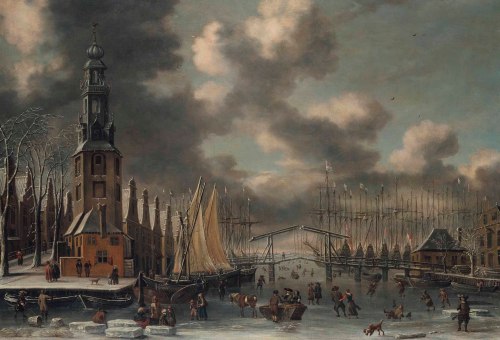 Artists: Thomas Heeremans (1641–1694) and Abraham Storck
Artists: Thomas Heeremans (1641–1694) and Abraham Storck
Title: English: Winter landscape with the Montelbaanstoren, Amsterdam
Genre: marine art
Date: 1690
Medium: oil on canvas
Dimensions: 29 7/8 x 42¾ in. (76 x 108.5 cm.)
What I love about this painting:
It is afternoon and the workday has ended. The people of Amsterdam are shown enjoying leisure activities on the Oudeschans canal, which they would not have done on a Sunday. Most people were Calvinists, and just as the Puritans did, they had a strict idea of what activities were permissible on Sundays.
This is partly a fantasy painting, as all really good paintings are. The intent of the composition is to show the wealth of Amsterdam and the vast fleet of merchant vessels that enable that prosperity. Some people are skating, some are fishing, and some are conducting business. Perhaps they are arranging for deliveries of goods to their warehouse. Or maybe they’re contracting for a ship to convey their goods to a distant market. Everyone looks busy and well fed.
While Abraham Storck’s staffage explores a conglomeration of the leisure activities enjoyed by the good and affluent people of Amsterdam, Thomas Heereman’s depiction of the landscape and weather is the truth of a particular winter day. I love the way the sky is shown, with the heavy clouds blowing across the blue sky.
Winter skies often look that way here in the Pacific Northwest.
About the Artists via Wikipedia:
Thomas Heeremans (1641–1694) was a Dutch painter and art dealer. He is known for his landscapes of winter scenes, cityscapes, harbor scenes, beach views, river views and village scenes. He was influenced by Klaes Molenaer, a slightly older painter also from Haarlem. Heeremans sometimes collaborated with specialist figure painters who would add the staffage in his landscapes. One of his collaborators was Abraham Storck, who painted the figures in the Winter landscape with the Montelbaanstoren, Amsterdam (Christie’s New York sale of 14 April 2016, lot 247). [1]
Abraham Storck (or Sturckenburch; bapt. 17 April 1644 in Amsterdam – buried 8 April 1708) was a Dutch painter, who enjoyed a reputation for his marine paintings, topographical views and Italianate harbour scenes. Storck was also an outstanding draughtsman. [2]
About the tower that is featured in this painting, via Wikipedia:
The Montelbaanstoren is a tower on bank of the Oudeschans – a canal in Amsterdam. The original tower was built in 1516 as part of the Walls of Amsterdam for the purpose of defending the city and the harbour. The top half, designed by Hendrick de Keyser, was extended to its current, decorative form in 1606. Since then the tower has been 48m tall.
Because the 3rd Duke of Alba proposed incorporating the tower into a castle (the Monte Albano) the tower became known in Dutch as the Monte Albano Toren. Over the years this became garbled to “Montelbaanstoren.” The castle was never built. [3]
Credits and attributions:
IMAGE: File:Thomas Heeremans and Abraham Storck – Winter landscape with the Montelbaanstoren, Amsterdam.jpg – Wikipedia (accessed January 24, 2024).
[1] Wikipedia contributors, ‘Thomas Heeremans’, Wikipedia, The Free Encyclopedia, 3 August 2023, 03:09 UTC, <https://en.wikipedia.org/w/index.php?title=Thomas_Heeremans&oldid=1168498581> [accessed 24 January 2024]
[2] Wikipedia contributors, “Abraham Storck,” Wikipedia, The Free Encyclopedia, https://en.wikipedia.org/w/index.php?title=Abraham_Storck&oldid=1164037737 (accessed January 24, 2024).
[3] Wikipedia contributors, “Montelbaanstoren,” Wikipedia, The Free Encyclopedia, https://en.wikipedia.org/w/index.php?title=Montelbaanstoren&oldid=1179532747 (accessed January 24, 2024).

![Frost Fair on the River Thames near the Temple Stairs, by Thomas Wyke ca.1683-1684 via Wikimedia Commons (scan from FT magazine, 2007-09-30) [Public domain]](https://conniejjasperson.com/wp-content/uploads/2018/01/375px-thomas_wyke-_thames_frost_fair.jpg?w=500)
![The Huis Kostverloren on the Amstel by Jacob van Ruisdael [Public domain]](https://conniejjasperson.com/wp-content/uploads/2019/07/huis_kostverloren_aan_de_amstel2.jpg?w=500)
![Summer Landscape with Harvesting Farmers, by Fredrik Marinus Kruseman 1850 [Public domain] via Wikimedia Commons](https://conniejjasperson.com/wp-content/uploads/2019/06/kruseman_fredrik_marinus_summer_landscape_with_harvesting_farmers_1850_oil_on_panel.jpg?w=500)






